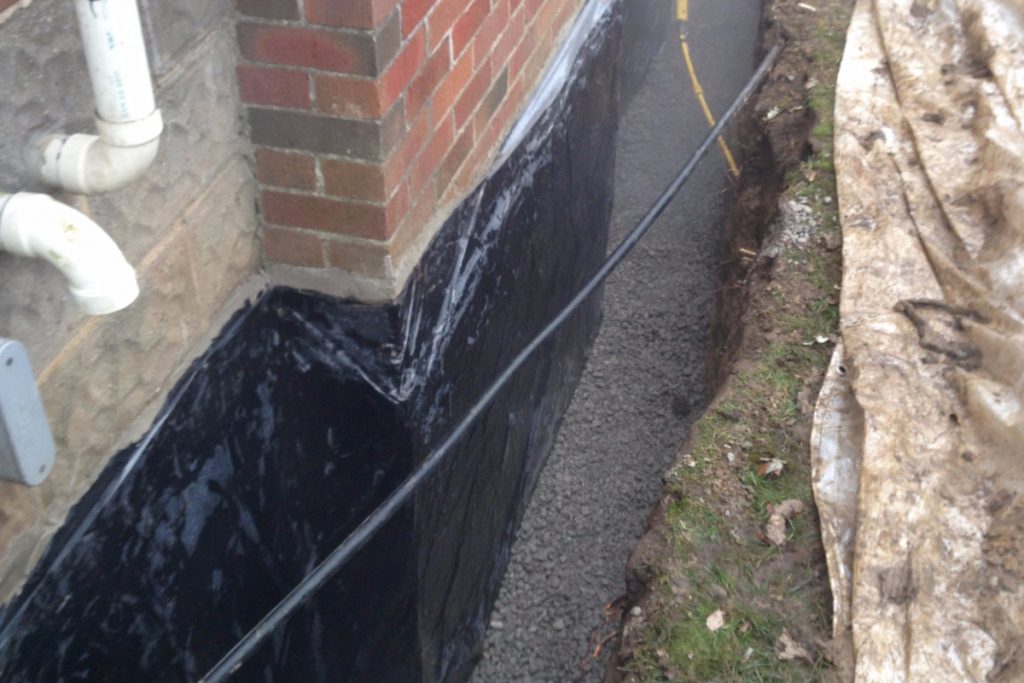Table of Contents
Coating the Foundation
The Damp Proof Membrane
Weeping Tile Replacement
What Matters Most – Quality or Price?
When it comes to concrete block basement waterproofing you have the option of two methods:
- Excavating the foundation and applying a waterproof coating to the foundation walls; and
- Installing an interior perimeter drain system.
Both of these waterproofing methods are effective in keeping your basement dry. However, there are significant differences between the two approaches to waterproofing your basement. We believe that a client should understand the key differences between the two systems before they enter into a contract to waterproof their concrete block / cinder block basement.
The conventional way of waterproofing a concrete block foundation is excavation of the foundation in order to waterproof the basement walls; of course this also includes weeping tile replacement. An increasingly popular choice for waterproofing this type of foundation is the installation of an internal perimeter drain system, usually involving the installation of a sump pump as well. In this article we examine the details of external excavation and waterproofing that likely matter the most to you.
External concrete block foundation excavation and waterproofing
One of the key benefits of excavating all or part of your foundation to waterproof your basement is the applied protective coating, as well as the installation of perfectly functioning new weeping tile.
Coating the foundation
A concrete block foundation built between 1920 and 1950 will typically have a coat of parging over top of the concrete blocks. During that time, waterproof coatings were not typically applied. Since the 1950s, and even today, most concrete block foundations will have been sprayed with tar. This application of tar is mandated by the current Ontario building code.
Over time, this sprayed-on tar has proven itself to be woefully inadequate, this is because cracking of the mortar joints between the concrete blocks is quite common and the sprayed on tar does not stretch when this cracking occurs. It is for this reason that the top waterproofing contractors in the greater Toronto area will apply an elastomeric rubber coating when they are waterproofing concrete block foundations. These elastomeric rubber coatings are typically capable of stretching between 500% and 1500%; therefore, the development of cracks in these concrete block foundation walls does not affect the effectiveness of the waterproofing.
Another key advantage to applying elastomeric rubber coating onto a block foundation wall is that the coating prevents the foundation concrete from coming into contact with the wet soils around the foundation. Unprotected foundations that have been exposed to water over several decades will typically show signs of deterioration; therefore, the application of a foundation coating will extend the life of the foundation.
The damp proof membrane
When a foundation is excavated for the purpose of waterproofing, among professional waterproofing contractors, two layers of protection are used. The first layer is the foundation coating and and the second is the air gap membrane. This air gap membrane, also referred to as foundation wrap or dimpled sheet membrane, is applied over top of the foundation coating for the purpose of damp proofing the foundation. This membrane does not waterproof a concrete block foundation wall; rather, the membrane keeps the wet soil around the foundation from coming into contact with the foundation. This damp proofing is important because concrete is a porous material and will readily absorb water from the soil. Damp concrete / cinder blocks leads to the accelerated deterioration of the concrete block foundation.
Weeping tile replacement
The weeping tile that is installed around the perimeter of the home has the role of evacuating water that tends to accumulate around the footing. Over time, the weeping tile tends to gradually become obstructed with sediment that accompanies the water that drains downwards through the soil. Weeping tile efficiency is desirable; therefore, every professional waterproofing contractor will replace the weeping tile along those sections of the concrete block foundation, which are excavated and waterproofed.
What Matters Most – Quality or Price?
Apart from your willingness to endure the destruction associated with excavating your foundation, the cost of waterproofing your concrete block foundation is another important consideration. In most cases, the cost of externally waterproofing your foundation is higher than the cost of installing an internal perimeter drain system.
It is common among homeowners to obtain 3 waterproofing quotes; for some, 3 contractors are contacted in order to obtain independent opinions, for others, they are trying to find out which contractor will offer them the best price. Getting the best price is financially responsible; however, for anyone waterproofing their foundation for the long term, quality of the basement waterproofing should be the prime consideration.
In order to determine which contractor offers the highest quality of concrete block basement waterproofing, ask questions. It is crucial to ask questions concerning the elasticity of the foundation coating and to ensure that the waterproofing work will be executed professionally.
